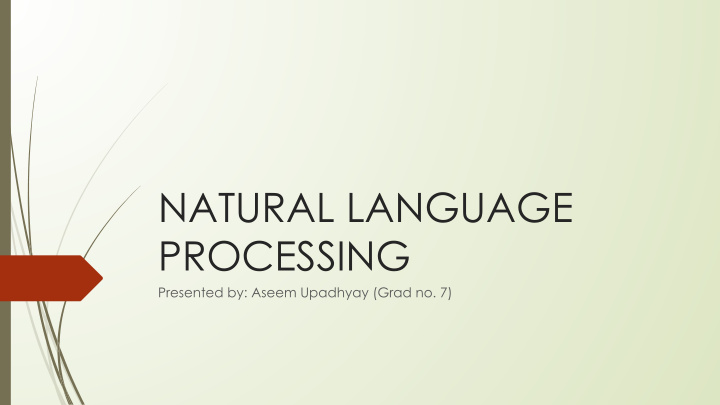



NATURAL LANGUAGE PROCESSING Presented by: Aseem Upadhyay (Grad no. 7)
What is NLP? “Natural” languages • English, Hindi, Mandarin, French, Swahili, Arabic, Nahuatl, …. • NOT Java, C++, Perl, … • Ultimate goal: Natural human-to-computer communication • Sub-field of Artificial Intelligence, but very interdisciplinary • Computer science, human-computer interaction (HCI), linguistics, cognitive • psychology, speech signal processing (EE), …
SHALL WE PLAY A GAME? Image from WARGAMES (1983)
REAL WORLD NLP
How Does NLP work? Always two parts : Understanding and Generation • Morphology : Identification of the structure of a word, such as the root word, • suffixes, prefixes etc. Lexicography: What does each word mean? • He plays bass guitar. • That bass was delicious! • Syntax: How do the words relate to each other? • The dog bit the man. ≠ The man bit the dog. • But in Russian: человек собаку съел = человек съел собаку •
Semantics: How can we infer meaning from sentences? • I saw the man on the hill with the telescope. • Discourse: How about across many sentences? • President Bush met with President-Elect Obama today at the White House. He • welcomed him, and showed him around. Who is “he”? Who is “him”? How would a computer figure that out? •
Why is NLP hard? Highly ambiguous at all levels • Complex and subtle use of context to convey meaning • Fuzzy • Involves knowledge about the world • Understanding how people interact with each other (persuasion, sarcasm, • insulting etc. )
Image taken from one of Dr. Chris Manning’s presentations
Question answering A: And, what day in May did you want to travel? C : OK, uh, I need to be there for a meeting that’s from the 12th to the 15th. Note that client did not answer question. Meaning of client’s sentence: • ▪ Meeting Start-of-meeting: 12th End-of-meeting: 15th ▪ Doesn’t say anything about flying!!!!! How does agent infer client is informing him/her of travel dates? •
May want to ask • questions about non-English, non-text documents… and get responses back in English text.
Machine Translation About $10 billion spent annually on human translation • Hotels in Beijing, China • In Chinese: 昨天我打 电话订 的 时 候 艺龙 信誓旦旦的保 证说 是四星 级 的酒店 , 住 进 去 以后一看没 , 我靠 , 这 在 80 年代可能算得上是四星的 , 我要的是 368 的大床房 , 房 间 只有 一个 0.5 米 *1 米的小窗 户 , 打开一看 , 我靠 , ... In English :Yesterday, I called out when Art Long vowed to ensure that the four-star hotel, to live in. I see no future, I rely on it in the 80s may be regarded as a four-star, and I want the big 368-bed Room, the room is only one 0.5 m * 1-meter small windows, what we can see, I rely on, ...
Why is machine translation hard? Requires both understanding the “from” language and generating the “to” • language. How can we teach a computer a “second language” when it doesn’t • even really have a first language?
Speech Processing Speech Recognition • Automatic dictation, assistance for blind people, text-to-speech, speech-to-text … • Factors that affect speech recognition … • How does intonation affect semantic meaning? • Detecting uncertainty and emotions • Detecting deception! • Why is this hard? • Each speaker has a different voice (male vs female, child versus older person) • Many different accents (Scottish, American, non-native speakers) and ways of speaking • Conversation: turn taking, interruptions, … •
Example from one of Dr. Julia Hirschberg’s presentations
Summarization Two approaches : Extraction and • Abstraction Due to the problem of • information overload i.e. availability of excess information, which hides the desired part of the information, the need for summarization is also increasing. The challenge here is that the • summary should not miss out on any of the important elements or lose the actual meaning of the original document.
Assisted Text Input Various approaches provide for detecting and recognizing text to enable a • user to perform various functions or tasks. For example, a user could point a camera at an object with text, in order to • capture an image of that object. This image can be digitally processed, and it’s meaning extracted • DIP TEXT or VOICE generation
References Christopher D. Manning. 1991. Lexical Julia Hirschberg and Christopher D. • • Manning. 2015. Advances in natural Conceptual Structure and Marathi. ms. Stanford University, Stanford CA. language processing. Science 349(6):261-266. Christopher D. Manning. 1995. Ergativity: • Argument Structure and Grammatical Christopher D. Manning. 2016. Texting and • Relations. Paper presented at the 69th Talking ... with Language-Understanding Computers? Boao Review . annual meeting of the Linguistic Society of America, New Orleans. R. Mihalcea. 2004. “ Graph-based ranking • algorithms for sentence extraction, applied Joan Bresnan, Shipra Dingare, and • Christopher D. Manning. 2001. Soft to text summarization.” In Proceedings of the 42nd Annual Meeting of the Association Constraints Mirror Hard Constraints: Voice and Person in English and Lummi. for Computational Linguistics (ACL 2004) (companion volume), Barcelona, Spain. Proceedings of the LFG01 Conference , pp. 13-32, Hong Kong www.cs.columbia.edu/~julia/talks/afosr14.p • ptx Roger Levy and Christopher D. Manning. • 2003. Is it harder to parse Chinese, or the cse.unl.edu/~choueiry/S02-976/Davis-NLP-O • Chinese Treebank? ACL 2003 , pp. 439-446. verview_of.ppt
Recommend
More recommend